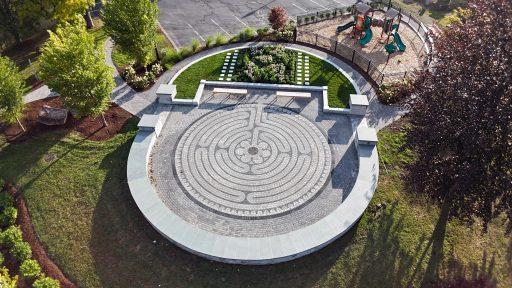Welcome to the South Church Labyrinth.
A labyrinth is an ancient symbol that relates to wholeness, combining the imagery of the circle and the spiral into a meandering but purposeful path. The labyrinth represents a journey to our own center and back again out into the world. They have long been used to enhance prayer and meditative practice. Labyrinth walking allows us to engage our whole bodies in prayer and is sometimes referred to as “praying with our feet.”
There is no right way to walk a labyrinth, but here are some suggestions for getting started:
Set your personal environment by eliminating anything that may serve as a distraction to you or other walkers, including silencing your cell phone if possible. Since our labyrinth is in a public setting, you can expect interruptions in the forms of other people in the Memorial Garden, children on the playground, other prayer-walkers on the labyrinth, and sounds from the surrounding community. Rather than allowing these interruptions to detract from your prayerful experience, you can choose to be curious about them and how they might enhance your encounter with the sacred.
On the labyrinth you can take:
- Intentional Walks: Hold a specific intention, issue, or concern as you walk. You can choose to write your intention and tuck it in your pocket or just hold it in your heart and mind to carry with you to the center.
- Intercessory Walks: Offer prayer(s) for people or needs, perhaps praying for a different person at each turn on the path or, like the intentional walk, write names or needs on a slip of paper to carry with you to the center.
- Meditative Walks: Meditate on a specific word or passage or pray repetitively, e.g., “Let peace prevail on earth;” “Loving God, meet me where I am and guide me in your Way (or Word);” “Christ behind me, Christ before me, Christ beside me.”
The walk can be broken down into stages:
- Entering: During this stage, you walk the path toward the center, trying to acquire a relaxed, peaceful state, temporarily releasing concerns and quieting your mind.
- Illumination: The time in the center. This is a time of openness and peacefulness during which you experience, learn, or receive what this unique moment offers. Take your time.
- Union: The journey outward. You choose when to leave the center, following the same path. This is a time to review and consider what occurred in the center and how it applies to your life.
- Implementation: This stage represents your life outside the labyrinth—the world into which your experience or illumination is carried and how it affects your everyday life.
Labyrinths and mazes have often been confused. When most people hear of a labyrinth, they think of a maze, but a labyrinth is not a maze. A maze is like a puzzle to be solved. It has twists, turns, and blind alleys. It is a left-brain task that requires logical, sequential, analytical activity to find the correct path into the maze and out.
A labyrinth, on the other hand, has only one path. It is unicursal—the way in is the way out. There are no blind alleys as the path leads you on a circuitous journey to the center and out again. The labyrinth is a right-brain task. It involves intuition, creativity, and imagery. While a maze requires making choices, with a labyrinth there is only one choice to be made: whether to enter or not.
Blessed be as you take this sacred journey.
There are thousands of other labyrinths across the world. Here’s a website to locate one wherever your life journey takes you: https://labyrinthlocator.org

